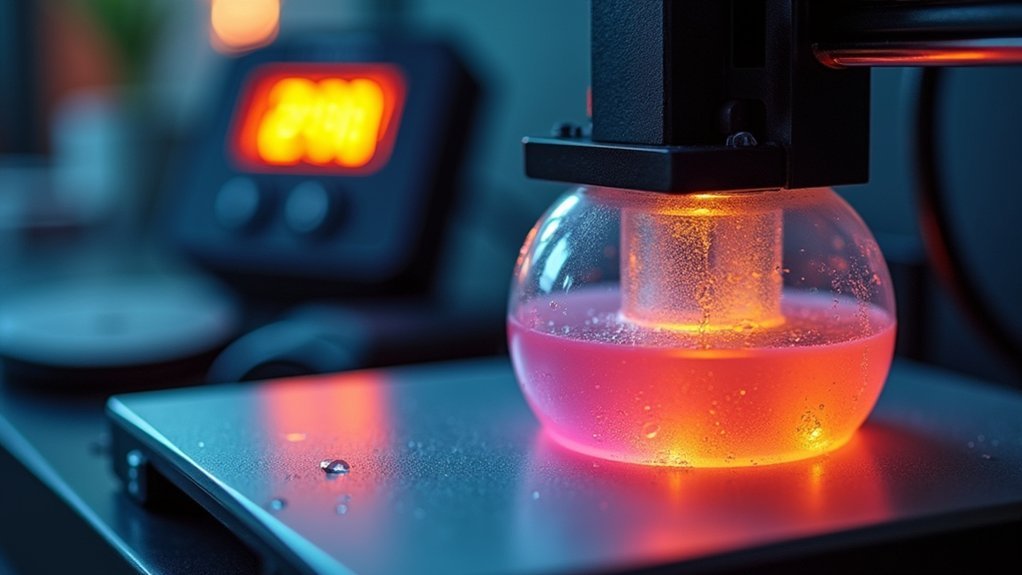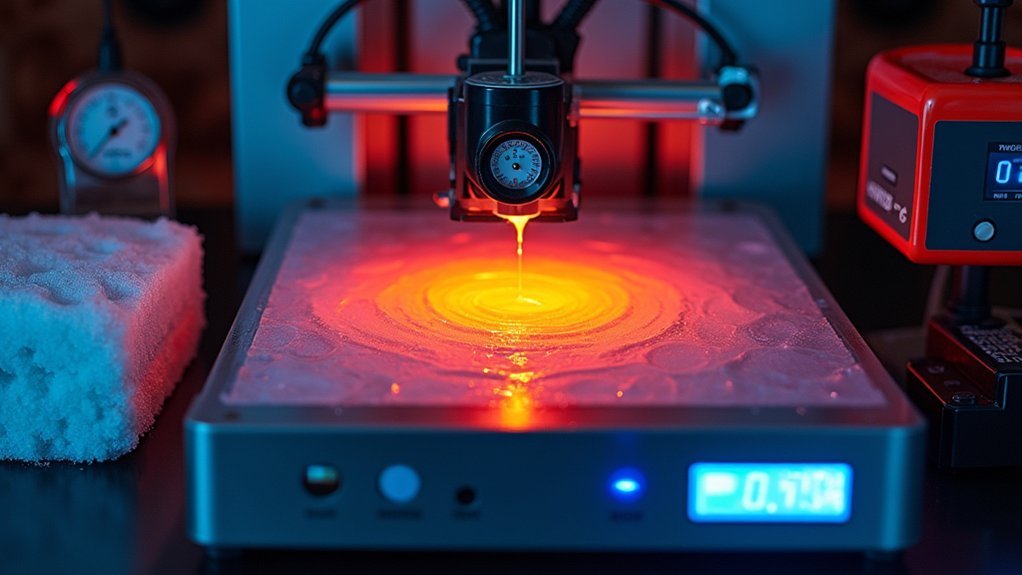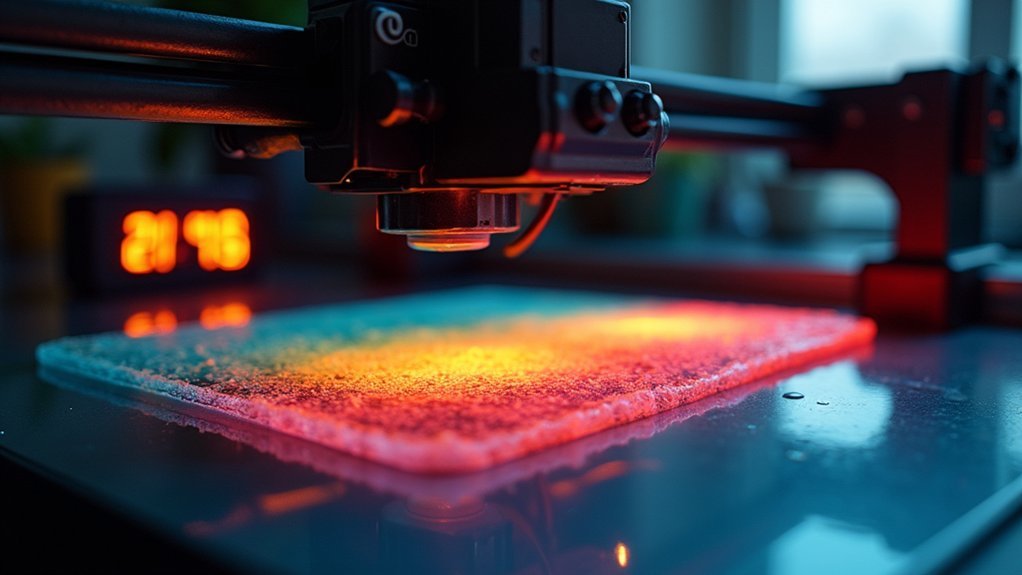You’ll need to maintain your resin printing environment between 24°C to 30°C (75°F to 86°F) for ideal results. Below 20°C, your resin thickens and requires 20% longer exposure times, while temperatures above 35°C can cause instability issues. Cold temperatures lead to incomplete curing and fragile prints, so you should consider using enclosures with heaters to maintain consistent conditions. Proper temperature control directly impacts your print quality, layer adhesion, and overall success rates throughout the entire printing process.
Optimal Temperature Range for Resin Printing Performance

When setting up your resin printer, temperature control becomes one of the most critical factors determining print success.
You’ll want to maintain your printing environment between 24°C and 30°C (75°F to 86°F) for ideal performance. Below 20°C (68°F), you’ll notice decreased curing efficiency, leading to print failures and poor layer adhesion.
Temperatures above 35°C (95°F) create instability issues that may require specific manufacturer adjustments.
High temperatures beyond 35°C destabilize resin printers and demand manufacturer-specific calibration adjustments for optimal performance.
Consistency matters just as much as the actual temperature. You’ll need to prevent fluctuations during printing, as these cause exposure inconsistencies and print defects.
Maintaining steady temperature within the ideal range prevents viscosity problems and guarantees proper curing times, giving you reliable, high-quality prints every time. Different resin types have varying temperature sensitivities, so understanding your specific resin properties helps optimize your environmental setup for maximum print quality.
How Cold Temperatures Impact Print Quality and Success Rates
Cold temperatures create significant challenges that directly undermine your printing success rates and final print quality.
When your resin gets cold, it becomes thicker and less reactive, requiring 20% or more additional UV exposure time to cure properly. Below 18°C, you’ll likely face incomplete curing that produces fragile, failed prints with visible defects and poor layer adhesion.
Temperature fluctuations during printing cause even more problems. If you add cold resin mid-print or experience sudden temperature drops, you’ll see layers cure inconsistently, creating structural weaknesses and texture variations.
Parts may detach mid-print, and layer separation becomes common. These temperature inconsistencies substantially reduce your success rates while increasing resin waste from frequent failures, making cold-weather printing particularly challenging without proper temperature control measures. Professional printers often include sealed print chambers that maintain consistent internal temperatures and minimize failures from environmental temperature variations.
Why Resin Viscosity Changes With Temperature Fluctuations

You’ll notice resin viscosity changes dramatically with temperature because heat affects how fast resin molecules move and slide past each other.
When temperatures drop, your resin’s molecular movement slows down, creating internal friction that thickens the material and makes it resist flowing smoothly. This thicker resin requires longer resting times for proper flow into gaps between layers and printer components.
As you warm the resin, increased molecular activity reduces this internal resistance, allowing the material to flow more freely through your printer’s mechanisms.
Molecular Movement Temperature Effects
As temperature fluctuations occur in your printing environment, the molecular behavior of resin undergoes dramatic changes that directly impact your print quality. When you heat resin, you’re energizing molecules and increasing their kinetic energy, which reduces intermolecular forces and lowers viscosity.
| Temperature Range | Molecular Motion | Printing Impact |
|---|---|---|
| Below 20°C | Reduced movement | Thick, slow flow |
| 20-30°C | Ideal activity | Best print results |
| Above 35°C | Excessive motion | Light scattering issues |
Higher molecular mobility enhances free radical movement during photopolymerization, creating more frequent molecular collisions that improve curing efficiency. You’ll notice faster reaction rates and better layer formation when maintaining proper temperatures. Conversely, cooling slows molecular rearrangement, increasing viscosity and reducing your print success rates considerably. Excessive heat can lead to thermal degradation of the polymer chains, permanently compromising material integrity and print strength.
Cold Thickening Mechanisms
When temperatures drop below ideal ranges, your resin undergoes fundamental structural changes that greatly increase its viscosity through several interconnected mechanisms.
As cold conditions set in, your resin molecules form transient networks and micro-domains that create substantial resistance to flow. The polymer chains experience strengthened hydrogen bonding and van der Waals forces, while reduced free volume restricts molecular mobility throughout the matrix.
These changes create a gel-like thickening effect that impacts your printing performance:
- Microgelation occurs before actual curing begins
- Shear viscosity increases greatly, slowing resin flow
- Surface tension alterations affect leveling on build platforms
- Bubble entrapment increases due to reduced escape rates
You’ll notice longer recoating times and potential adhesion issues between layers when your resin becomes too cold. Lower ambient temperatures significantly compromise the curing reaction efficiency, preventing proper layer bonding even when exposure times remain unchanged.
Heat Reduces Flow Resistance
While cold temperatures create molecular networks that thicken your resin, heat works in the opposite direction by breaking down these restrictive bonds and dramatically reducing flow resistance.
When you increase temperature, you’re disrupting the polymer chain interactions that create viscosity, allowing molecules to move more freely through the liquid.
This molecular mobility improvement has immediate practical benefits for your prints. Your heated resin returns faster under the build plate after each layer lift, creating more consistent printing conditions.
The reduced stickiness also means less adhesion to your FEP film, preventing potential damage during layer separation.
Additionally, thinner resin from proper heating enables more uniform UV light penetration during curing, which can actually reduce your required exposure times while improving overall print quality and reliability. Hot resin also demonstrates higher reactivity compared to its cold counterpart, contributing to more efficient curing processes.
Temperature Effects on UV Curing and Layer Adhesion

Temperature plays a critical role in resin printing’s UV curing process, where photoinitiators trigger an exothermic reaction that converts liquid monomers and oligomers into solid polymers.
This reaction releases heat that can raise your part’s temperature beyond ambient conditions, sometimes considerably affecting the final result.
You’ll achieve ideal curing around 60°C for most standard resins, which balances efficiency and stability. Thermal post-curing can significantly enhance print strength beyond what UV light alone provides.
However, exceeding your resin’s heat deflection temperature risks warping and poor layer adhesion.
Key temperature considerations for successful curing:
- Maintain uniform heating to prevent thermal gradients between layers
- Monitor for temperature spikes from exothermic reactions
- Use lower temperatures (around 44°C) for flexible resins to minimize warping
- Verify controlled convection prevents hot spots that degrade fine features
Room Heating Solutions for Consistent Print Environment
Managing your print environment’s ambient temperature requires strategic room heating solutions that maintain the ideal 24-30°C range consistently throughout your printing sessions.
Electric space heaters with built-in thermostats provide reliable control with adjustable settings, while central HVAC systems offer broader coverage but may need supplemental heating near your printer.
Position thermostats close to your printing area for accurate temperature regulation, avoiding manual heating methods that create inconsistency.
Improve efficiency by combining portable heaters with proper insulation—seal windows, doors, and use draft stoppers to prevent cold air intrusion.
Consider enclosures around your printing area to retain heat and reduce the space you’ll need to warm.
Radiant heaters distribute steady, even heat, though avoid infrared heaters that may create uneven ambient air temperatures and inconsistent resin viscosity. Standard fan heaters cause temperature spikes that can lead to expansion and contraction lines appearing in your finished prints.
Printer Enclosure and Heating System Options
Creating a controlled microenvironment around your resin printer offers a more targeted approach to temperature management than heating entire rooms.
Printer enclosures retain heat effectively while minimizing temperature fluctuations that can affect print quality. They’ll help you maintain the ideal 20°C to 30°C range more efficiently and cost-effectively.
For heating systems, you’ll need different wattages depending on your environment:
- 250W ceramic heaters work well in mild conditions (down to -5°C ambient)
- 500W heaters handle colder environments (down to -35°C ambient)
- Small 6.5W heat pads provide modest temperature increases in mild conditions
- Thermostats enable precise temperature control within the critical range
Enclosures also provide essential fume control while creating temperature stability for consistent results. A controlled environment significantly minimizes print failures caused by environmental factors.
Resin Storage Temperature Management Best Practices
While proper printer temperature control guarantees successful printing, your resin’s storage conditions directly impact its performance and longevity before it ever reaches the build plate.
You’ll want to store your resin between 5°C and 30°C (41°F-86°F), with room temperature around 18°C to 28°C being ideal.
Store resin between 5°C and 30°C, with room temperature around 18°C to 28°C being the sweet spot for optimal performance.
Don’t refrigerate resin, as temperatures below 5°C affect fluidity and can cause condensation issues.
Keep containers sealed in cool, dry areas away from UV light and chemicals that could trigger premature curing or degradation.
Always shake resin thoroughly before use since components settle during storage.
Store bottles upright in stable temperatures to prevent thermal cycling that degrades photoinitiators and shortens your resin’s one-year shelf life. If you experience persistent storage-related printing problems, contacting support can provide specialized troubleshooting assistance for your specific resin and printer combination.
Adjusting Exposure Times Based on Ambient Temperature
Beyond maintaining proper storage conditions, ambient temperature directly affects how your resin cures during printing, requiring you to adjust exposure times for ideal results.
When temperatures drop between 18°C and 24°C, you’ll need to increase exposure times by approximately 20% to compensate for slower curing. In colder conditions, test with calibration prints using 10-20% longer exposures to find best settings.
Key exposure adjustments based on temperature:
- Cold environments (18-24°C): Increase exposure by 20% minimum
- Warm conditions: Reduce exposure times as resin cures faster
- Test incrementally: Use calibration parts with 10-20% exposure variations
- Monitor consistency: Temperature fluctuations require ongoing adjustment
Conversely, warmer environments allow reduced exposure times since resin forms stronger bonds more quickly, preventing overexposure that causes detail loss. Remember that over-exposed prints lead to light bleeding and loss of fine features, making careful adjustment essential when working in varying temperatures.
Printer Setting Modifications for Temperature Variations
When ambient temperatures fall outside the ideal range, you’ll need to modify several printer settings beyond exposure time to maintain print quality.
Maintaining consistent print quality requires adjusting multiple printer parameters when environmental temperatures deviate from optimal conditions.
In colder environments, reduce lift speeds to allow proper resin flow since increased viscosity makes the material thicker and slower-moving. You’ll also need to adjust peel forces and layer separation speeds to compensate for this viscosity change.
Consider reducing overall printing speed to guarantee adequate curing and layer bonding when temperatures drop below suitable levels.
Some printer models allow you to modulate light intensity or power alongside temperature adjustments to enhance curing efficiency. Inadequate temperatures can lead to weak bonds between layers, compromising the structural integrity of your prints.
Run calibration prints at different temperatures to determine the best speed, lift, and curing parameters for your specific resin and environmental conditions.
Cost-Effective Temperature Control Strategies
You don’t need to break the bank to maintain proper resin temperatures during printing.
Heat pads and mats designed for temperature-sensitive applications offer a low-cost alternative to expensive ceramic heaters while still providing adequate warmth for your setup.
When combined with simple thermostats and proper enclosures, these DIY solutions can effectively manage your printing environment without the high energy costs of professional heating systems. Most resins perform optimally within a 25-30°C range, making temperature monitoring essential for consistent results.
Budget Heating Solutions
Since maintaining ideal resin temperatures doesn’t require expensive industrial equipment, you can achieve excellent results with strategic budget heating solutions.
Compact electric mini heaters offer intelligent temperature control specifically designed for small enclosures, costing considerably less than bulkier systems while maintaining stable heat without fluctuations. Modern units feature PTC rapid heating technology that efficiently warms printing environments while consuming minimal power.
You can also leverage your existing ventilation system by adjusting fan speeds to modulate ambient temperature.
Slowing fans in colder settings helps warm resin to optimal printing temperatures, while increased speeds cool overly warm environments.
For advanced control without breaking your budget:
- Use programmable temperature controllers with custom heating profiles for different resins
- Install separate heating circuits for print head and build platform independence
- Combine electric heating tubes with ventilated cooling systems
- Integrate heating elements with anti-ash nets for even heat distribution
DIY Temperature Management
Building on cost-effective heating strategies, DIY temperature management takes control into your own hands with simple yet effective solutions that don’t require professional installation.
You’ll want to create an enclosed printing chamber using foam insulation or thermal blankets to trap heat and stabilize temperatures around your printer. A 250-500W ceramic heater with built-in thermostat provides precise control in enclosed spaces.
Position temperature sensors inside your enclosure to monitor conditions dynamically. For extreme cold environments down to -35°C, you’ll need a 500W heater to maintain ideal resin temperatures near 30°C. A properly sized heater can reach target temperatures in just 5 minutes when starting from moderately cold conditions.
Avoid sudden temperature spikes by using controllers compatible with your heating element’s power rating.
Temperature Monitoring and Calibration Techniques
When resin temperatures fluctuate outside the ideal 20°C to 30°C range, your prints will suffer from poor layer adhesion, inconsistent curing, and potential failures.
You’ll need reliable monitoring and calibration methods to maintain consistent results.
Start by checking your resin manufacturer’s temperature guidelines, then use temperature tower prints to test different settings in one job.
External temperature probes or infrared thermometers help you monitor both ambient and resin temperatures inside your enclosure or vat. Formlabs provides technical assistance for printer setup and calibration to ensure optimal temperature management.
Essential calibration steps include:
- Document temperature readings during test prints for future reference
- Adjust exposure times and lift speeds based on temperature observations
- Focus on first layer adhesion, as temperature critically affects resin flow
- Maintain detailed logs for each resin type to streamline setup
Frequently Asked Questions
Can I Use a Hair Dryer to Quickly Warm up Cold Resin Before Printing?
You can use a hair dryer, but it’s risky. Direct heat creates hot spots and can prematurely cure resin. Instead, you’ll get better results using gentle, indirect warming methods.
Does High Humidity Affect Resin Printing Temperature Requirements?
High humidity doesn’t change your resin’s temperature requirements, but it creates environmental instability that affects printing. You’ll still need 24°C-30°C, but should add dehumidifiers to maintain consistent conditions.
Will Printing in Direct Sunlight Cause Resin Temperature Problems?
Yes, you’ll face serious temperature problems printing in direct sunlight. The heat raises resin temperature beyond ideal ranges, causes premature curing, creates inconsistent temperatures, and leads to print defects or failures.
Can I Print Outdoors in Summer Without Temperature Control Equipment?
You can print outdoors in summer if temperatures stay between 24-35°C, but you’ll risk print failures from temperature fluctuations, overheating above 35°C, and inconsistent curing without control equipment.
Does Resin Brand Affect the Ideal Temperature Range for Printing?
Yes, resin brands affect ideal temperature ranges since they’ve different chemical formulations. You’ll need to check manufacturer guidelines and test settings because specialty resins may require higher temperatures than standard ones.





Leave a Reply